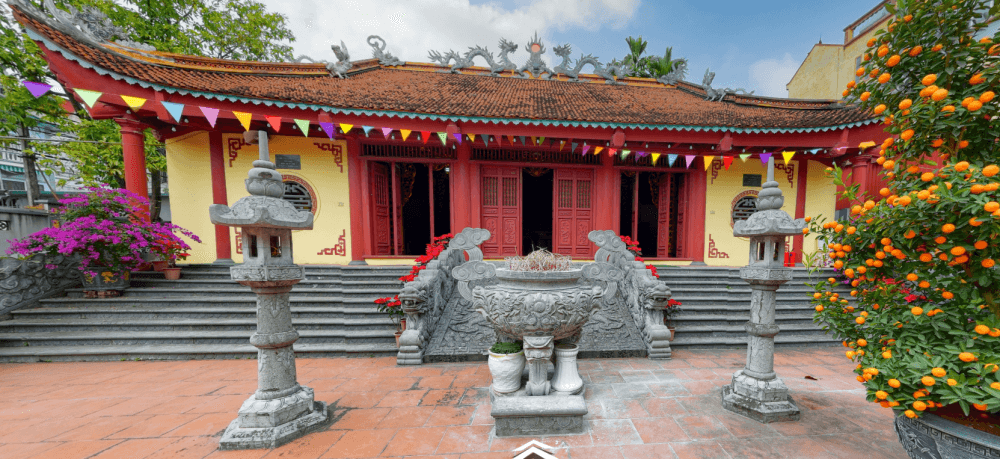

Introduce
Coming to Thuong Thuy village, Phu Thuong ward, Tay Ho district, Hanoi in the early days of spring, we can feel the feelings of the country soul. This was formerly a suburban village of Tu Liem district outside of Hanoi, near the Red River. For each village, the communal house is for worshiping the village god, where the meeting of local people are held and where every festival takes place. Thuong Thuy communal house is also one of the souls of a village of Hanoi.
Thuong Thuy communal house is located at 423 An Duong Vuong Street, Group 7, Area 1, Phu Thuong Ward, Tay Ho District, Hanoi.
The communal house has an early history of being created to worship gods that have merit with the local people. The old communal house was built quite simply nearby the river. According to the villagers, in the late Le dynasty, when the river was flooded, Thuong Thuy people moved into the dyke as the current location.
Based on the book of the myth and ordained and the records kept in the communal house, Thuong Thuy communal house worshiping the village god of Duc Long Vuong can be summed up as follows: in a full moon night, eight rulers of that time dreamed of a majestic figure, nine feet high in front of him and said: "I am the god of thunder in the sky, under the water I am the King, now following God’s will I came to ensure the life of people here."
"Then it was raining so the people heard the command of the Jade Emperor to set up a temple." This is the consummation of the heavenly spirit. In one of the scroll said, "There was a year when the water table of the Red River is very high, the mandarin that supervising the dyke heard that this place worship God whom is sacred, this authority order the people to immediately set up a ceremony to pray then suddenly the weather was good and the people in that area was living wealthy".
Every year, according to tradition, the people in the village commemorate the death anniversary on the 5th of August (lunar) and hold a ceremony to worship the gods on the 5th of May (lunar). They offer their utmost respect to the deities: "The Tutelary God is a heavenly being, who comprehends all matters, big or small. God commands the wind and rain with the power of thunder and lightning. God's majestic presence is recorded in the book of heaven. As the head of all aquatic creatures, God can change form at will. The Tutelary God is a revered ancient deity that everyone loves and admires. Today, we respectfully invite God to visit us, and we offer our worship to seek God's guidance and protection for our people. May the Tutelary God grant us favorable weather and calm winds, and may our people enjoy peace and prosperity. We rely on God's strength and assistance and pray for God's mercy."
Later, the kings of various dynasties bestowed the Tutelary God of a village as: "The Tutelary God is a divine being of the middle rank, whose benevolence is as deep as the ocean, and whose grace extends to all people in harmony with heaven. God's spirit guides the people to a happy and peaceful life."
Every year, to commemorate the divine merits of the Tutelary God, the villagers celebrate the village festival on the 12th of January (lunar), to express their gratitude and respect to the deity who has blessed them with favorable weather and peaceful life.
Previously, the communal house was of a small scale and simple, consisting of three rooms and two free spaces. In recent years, it has garnered attention from the local government of Tay Ho district and Phu Thuong ward, as well as various departments, especially the consciousness and voluntary contribution of funding from the people of Thuong Thuy. As a result, the communal house has undergone a significant renovation and its current appearance is quite grand and solemn.
Thuong Thuy communal house was built on a relatively spacious land in the center of the village of Thuong Thuy and turned to the west, the wall surrounded by around 2000m2.
In the end, the well is built in a circular shape, with an area of about 300m2. In the summer, the lotus flower blooms, creating a beautiful airy space for the communal house.
Nghi gate: Four pillars in the center of the square consist of two rectangular pillars, the body has boxes to write characters on, the unmarked lanterns, the top of the pillars have four phoenixes tucked. From the two main columns run straight to the right and the left two small pillars to smooth non-parallel sentences, the top of the column is the two unicorns facing each other.
The main architectural works of the Thuong Thuy communal house include the main temple and the harem. The main temple consists of 5 new chambers renovated by the government and the people in recent times with modern materials of concrete that look like wood. Roof cover with tile, the angle of the roof is shown the tip of the dragon head facing the roof. In front is a wooden table door system. Thuong Thuy communal house is made on a high platform with 7 stone steps from the courtyard, in the middle of the outside of the house from the stone steps up to the two golden dragons (new by people do merit in recent times). In front of the dragon is a pair of lamps and incense burners also of blue stone.
The harem consists of 3 rooms, tile roof, in the middle of the roof is the sun. The foundation is quite high compared to the main temple. The frame is made simple by triangular hinges and in front of the system is a wooden door. In the center is the throne and tablet of the village god.
Especially, Thuong Thuy communal house also preserved the system of rich and varied relics of the type and material such as the system of ordained, the gods, bronze bell, throne, palanquin, parallel sentences ... brings very high cultural, scientific and aesthetic values and the original dating back to the Nguyen. These relics are a valuable source of valuable information contributing to the understanding of the history of the gods in the power system of the Vietnamese as well as the development of the village of Vietnam through different periods of the country's history.
Apart from historical values, Thuong Thuy communal house is also of cultural value. The communal house is a gathering place for cultural activities, spiritual beliefs of the villagers expressed gratitude to the people who have contributed to protect the peaceful life for the people to date. At the same time, it also brings together members of the village, leading people to the truth - good - beauty.
Artifacts
Map
Nearby Places
No. 43C, alley 497, quarter 2, group 15, Lac Long Quan Street, Nhat Tan Ward
54.13Km
No.6, Lane 319, An Duong Vuong Street, Phu Thuong ward
52.68Km
Lane 242, Lac Long Quan Street, Buoi Ward, Tay Ho District, Hanoi.
No. 20, Lane 472, Cluster 3, Lac Long Quan Road, Nhat Tan Ward, Tay Ho District, Hanoi.
No. 35, Lane 416, Lac Long Quan Road, Nhat Tan Ward, Tay Ho District, Hanoi.
53.68Km
No. 07, Lane 30, Tay Ho Road, Quang An Ward, Tay Ho District, Hanoi.
55.43Km
Residential Area No. 5 (No. 3, Lane 200, Au Co Road), Tu Lien Ward, Tay Ho District, Hanoi.
56.02Km
Residential Area No. 5 (No. 3, Lane 200, Au Co Road), Tu Lien Ward, Tay Ho District.
55.91Km